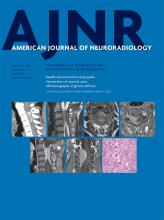Abstract
BACKGROUND AND PURPOSE: Intrinsic T1-hyperintense signal has recently been reported in the deep gray nuclei on brain MR imaging after multiple doses of gadolinium-based contrast agents. Most reports have included adult patients and excluded those undergoing radiation or chemotherapy. We investigated whether T1 shortening is also observed in children and tried to determine whether radiochemotherapy is a risk factor for this phenomenon.
MATERIALS AND METHODS: In this single-center retrospective study, we reviewed clinical charts and images of all patients 18 years of age or younger with ≥4 gadobenate dimeglumine–enhanced MRIs for 6 years. Seventy-six children (mean age, 9.3 years; 60 unconfounded by treatment, 16 with radiochemotherapy) met the selection criteria (>4 MR imaging examinations; mean, 8). T1 signal intensity ratios for the dentate to pons and globus pallidus to thalamus were calculated and correlated with number of injections, time interval, and therapy.
RESULTS: Among the 60 children without radiochemotherapy, only 2 had elevated T1 signal intensity ratios (n = 20 and 16 injections). Twelve of the 16 children with radiochemotherapy showed elevated signal intensity ratios. Statistical analysis demonstrated a significant signal intensity ratio change for the number of injections (P < .001) and amount of gadolinium (P = .008), but not for the interscan time interval (P = .35). There was a significant difference in the average signal intensity ratio change between those with and without radiochemotherapy (P < .001). Chart review revealed no new neurologic deficits in any patients, related to their underlying conditions and prior surgeries.
CONCLUSIONS: Compared with published adult series, children show a similar pattern of T1 hyperintense signal changes of the dentate and globus pallidus after multiple gadobenate dimeglumine injections. The T1 signal changes in children may have a later onset but are accelerated by radiochemotherapy.
ABBREVIATION:
- RCTX
- radiochemotherapy
- © 2018 by American Journal of Neuroradiology












